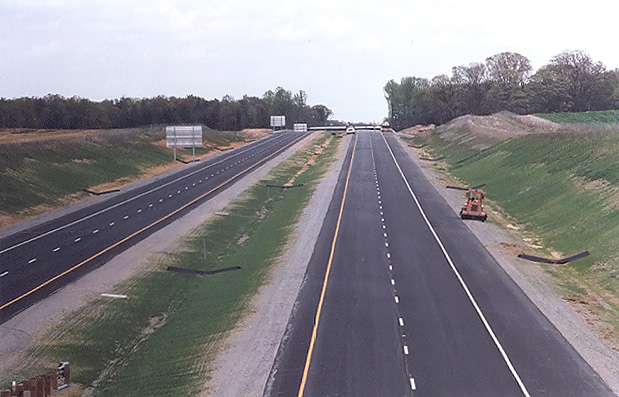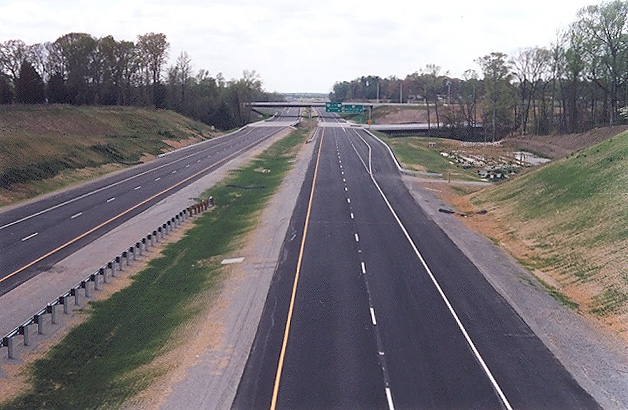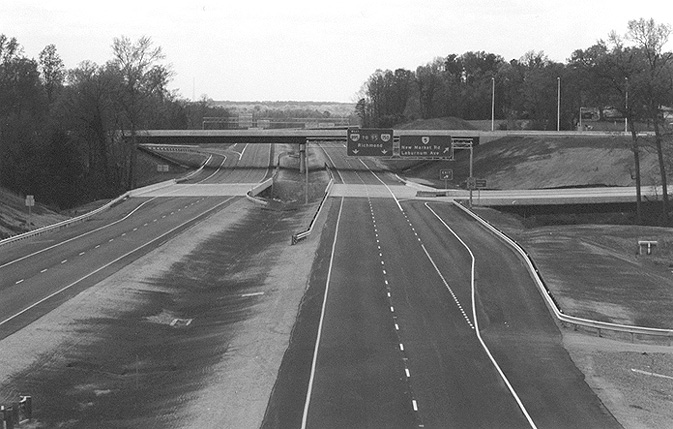Route 895 Construction – April 2002
Here's
more photos of Route 895 under construction, taken April, 2002. As you can see, this section is virtually traffic-ready, but was not open to traffic when these photos were taken.

Above,
I'm standing on the VA-5 New Market Road overpass, looking east onto Route 895. On this
section, soil was excavated, and stabilization material was placed over
the area, with a layer of over 3 feet of heavy crushed stone about the grade
of railroad ballast. This whole section is a "bathtub"
where the highway goes through a deep excavation cut below the water table, and
a deep enough stone structure was placed so that it would resist the
hydrostatic pressure of the underground water, and there are extensive
underdrains to drain water from the layer of stone so that the roadway
structure will stay dry. A layer of aggregate base course was placed over the
layers of heavy crushed stone, and asphalt roadway was placed on top of the aggregate
base.
More details of this "bathtub" are here - Route 895 Construction - July 2001 - Photos 1-4, and here - Route 895 Construction - August 2001 - Photos 11-16, and here - Route 895 Construction - September 2001 - Photos 1-4.

Above, I'm
standing on the VA-5 overpass, looking west onto Route 895. This is also in the
"bathtub" area. Notice the stormwater management basin on the right side of the highway.
The entire land portion of Route 895 has an enclosed stormwater
management system. All storm water drainage is captured in a series of
stormwater management basins, and you can see them adjacent to the
highway as you drive it. The system can hold up to 6
inches of rain in a 24-hour period. This type of system is a recent new
development in highway environmental design, and from what I understand
it will be standard on future projects. The basins are large; they look
like up to an acre each, so they do require extra right-of-way. Various
combinations of ditches, drop inlets and underground pipes are used to
channel the storm water from the roadways to the stormwater management
basins. The basins have treatments that are designed to absorb the
various roadway runoff effluents such as oil, grease, rubber particles,
and metal particles. Periodic maintenance will extract the absorption
layer and take it to a sludge treatment plant, and will replenish the
absorption layer. So there is a significant extra cost to provide this
system, but it is something that I am strongly in favor of.

Above, I'm
standing on the VA-5 overpass, looking west onto Route 895. Same vantage point
as previous photo, taken a few minutes later, but with a 135mm (2.7x) telephoto
lens instead of the 50mm regular lens used in previous photo (black and white - sorry - my scanner did that due to the low light levels). The two mainline
bridges cross over Cornelius Creek, and the westbound bridge has a spur bridge
branching off to Ramp A, the westbound off ramp to the Laburnum Avenue
Connection. The completed overpass bridge is for the Laburnum Avenue
Connection.
©
Copyright 2001 by Scott Kozel, and all photos taken by same. All rights
reserved.
Lead
page for Route 895 Construction
Lead page for Route 895 Connector (Pocahontas Parkway)
By Scott M. Kozel, Roads to the Future
(Created 6-1-2002)